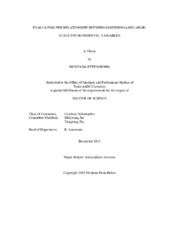| dc.description.abstract | The objective of this study is to determine the relationship between lightning and
six large-scale environmental variables: convective available potential energy (CAPE),
normalized CAPE (nCAPE), column saturation fraction (r), 700-hPa omega, 900-700 hPa
low-level wind shear (LS) and 900-300 hPa deep wind shear (DS). Lightning data is
obtained from the Tropical Rainfall Measuring Mission’s (TRMM) Lightning Imaging
Sensor (LIS) from 1998 to 2013 and large-scale environmental variables are derived from
3-hourly Modern-Era Retrospective analysis for Research and Applications version 2
(MERRA-2) data. Each dataset is binned at 0.5° x 0.5°. MERRA-2 data is considered to
represent a lightning environment when lightning occurs within 30 minutes of the
MERRA-2 time stamp.
CAPE, nCAPE and r show clear distinctions in lightning environments compared
to non-lightning environments and the largest flash occurrences are associated with lowto-
moderate CAPE, moderate nCAPE, slightly negative values of 700-hPa omega (i.e.,
rising motion), high r, low-to-moderate LS and low DS. Clear geographical distinctions
for flash occurrences exist between land and ocean for CAPE, nCAPE and r and between
tropical and sub-tropical areas for CAPE, nCAPE, r and DS. The relationship of r with
other variables for lightning occurrences is evaluated and it is shown that CAPE and
omega with r have the clearest relationships.
The association between large-scale environmental variables and lightning is
analyzed globally for latitudes between 35°N and 35°S using two statistical models. Using
a generalized linear model (GLM), nCAPE and r are the primary predictors for lightning
prediction. Using a point-process model, nCAPE is the best predictor, with strong regional
contrasts present. The GLM is used in a lightning parameterization to predict lightning
from MERRA-2 and the Community Atmosphere Model version 5 (CAM5). Predicted
lightning from both datasets generally agrees with observations from the TRMM LIS,
which supports the use of a lightning parameterization in GCMs. | en |


